Heart surgery’s Manhattan Project an Australian success story
The Australian man implanted with a groundbreaking artificial heart, developed after a 25-year quest in Brisbane, left hospital and spent time at home before having a successful transplant, doctors have revealed.
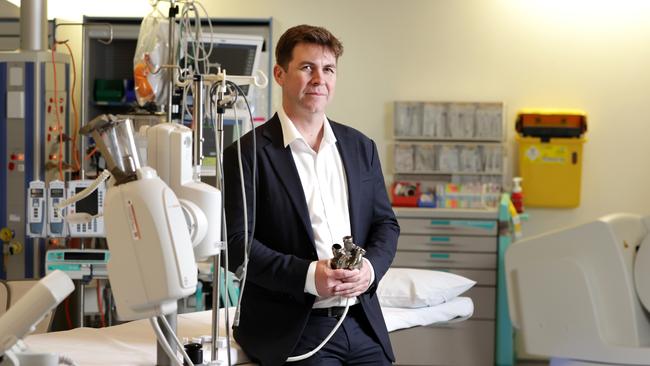
An historic operation to implant the first Australian patient with a revolutionary titanium heart has been branded an “unmitigated clinical success” with the man surviving for months without a human heart before undergoing a transplant.
The Bivacor artificial heart, invented by Brisbane-born Daniel Timms, was implanted in the first Australian patient last November, with the man surviving longer than anyone elsewith the titanium heart before receiving a transplant.
The man who had end-stage heart failure was able to walk from hospital in early February and spend time at home before a human donor heart was implanted last week.
“It is incredibly rewarding to see our device deliver extended support to the first Australian patient,” Dr Timms said. “It’s exhilarating to see decades of work come to fruition.”
For years, biomedical engineer Dr Timms’ project to invent the world’s first artificial heart that could keep a patient alive in the long-term without their own diseased heart was shrouded in secrecy. Dubbed heart surgery’s Manhattan Project, the rotary pump heart’s design was perfected in Dr Timms’ backyard shed and in the bowels of a Brisbane hospital where clinicians practised implanting early designs of the heart in sheep. The total artificial heart uses levitation of one spinning disc to do the work of both sides of the heart.
It has been implanted in four patients in the US as part of feasibility studies with successful results, and feasibility studies are continuing in Australia. Days before the November operation at St Vincent’s Hospital in Sydney, Dr Timms spoke to The Australian and described the mission to prove the heart’s safety and efficacy as “kind of like SpaceX”. “We’re on our way to Mars with this heart,” Dr Timms said at the time. We’re going to go to Pluto actually. But for now, we just need to be cautiously optimistic.”
The feasibility studies will continue throughout this year in Australia and the US and are aimed at proving the device works, with patients kept alive until they can have a heart transplant. The heart is designed, once it’s proven effective, to be able to keep patients alive for many years without requiring a transplant.
“Being able to bring Australia along this journey, all the way through the journey and be part of the first clinical trials is immensely important to me, and something that I set out to do from the very beginning,” said Dr Timms.
“We hear a lot of devices that are ideas that are born in Australia, and then they’re lost to the rest of the world, and we never really see them again until they’re maybe way down the track. I was determined to make sure there wasn’t a tie cut.”
Dr Timms invented the BiVACOR, a titanium artificial heart with an electromechanical rotary blood pump that is described as a paradigm shift in artificial heart design, largely during his PhD project completed at the Queensland University of Technology in Brisbane. Powered by perpetually moving rotating discs that levitate in a magnetic field and simultaneously pump blood to both the body and lungs, the heart is capable of providing high-flow cardiac output sufficient for an adult male undergoing exercise.
The artificial heart has a small external controller combined with a rechargeable battery system, which supports untethered operation from an AC power source to allow mobility and freedom of movement in the patient.
The first Australian patient’s surgery was performed by Australian heart transplant surgery, Dr Paul Jansz, and US cardiothoracic surgeon Dr Bill Cohn, in a historic operation to implant the first artificial titanium heart into an Australian patient with heart failure.
Dr Jansz on Wednesday dubbed the outcome of last November’s surgery an unmitigated success. ”We’ve worked towards this moment for years and we’re enormously proud to have been the first team in Australia to carry out this procedure,” he said.
Monash University’s Artificial Heart Frontiers Program is a partner in the Bivacor project, which is supported by $50 million from the Medical Research Future Fund. Monash’s Vice Chancellor and President, Professor Sharon Pickering, labelled the project a “shining example of the transformative innovation our nation can achieve”.
“This revolutionary milestone in Australian medical history is a triumph of science and a source of hope for patients and families. In my own family and for so many others this is a poignant reminder of the critical importance of medical research – made possible by the great relationships between universities, hospitals and industry – to improving and saving the lives of millions of Australians,” Professor Pickering said.
For the best part of a decade, Dr Jansz has been practising implanting the BiVACOR into bovine cadavers, and then live sheep, just like medics at the Prince Charles Hospital in Brisbane did many, many times during the titanium heart’s long development that began two decades ago.
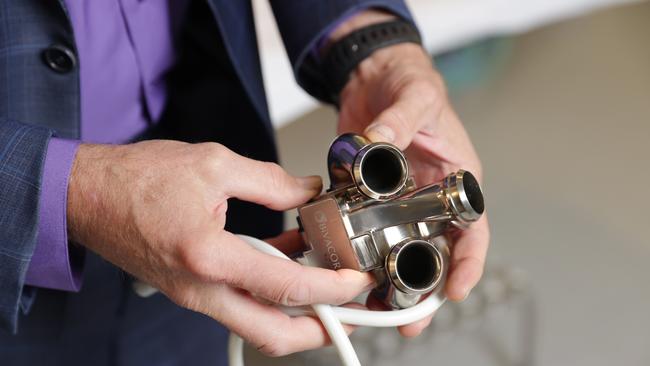
It was an era in which the single-minded Dr Timms barely slept, and when he did, it was on a black vinyl couch that the hospital’s ICU Professor John Fraser bought and had carted up to his office because Dr Timms had no wage and was so devoted to his work. Dr Timms kept his entire wardrobe in Professor Fraser’s small office and tinkered away at his tools day and night, driving his clinical colleague next door to distraction.
Eventually Professor Fraser joined the quest and began working closely with Dr Timms to perfect the device and build a team, including the heart transplant surgeon David McGiffin, who started implanting Dr Timms’ heart device into animals at Prince Charles Hospital. It was crucial early work that eventually led to this point.
Now, finally with the news that the operation has been highly successful, is the moment of truth on home soil.
Australia’s Medical Research Future Fund has funded a clinical trial to involve between five and 15 patients, which will progress after these feasibility studies. The venture is so exciting that venture capital funding is already in place, most of it coming from the Australian outfit OneVentures, whose founder Paul Kelly is an endocrinologist. Manufacturing and associated industries are beginning to gear up in Australia for the industry likely to be spawned by the BiVACOR.
“We see this as the next cochlear,” Dr Kelly says, referring to the celebrated Australian invention of cochlear implants. “It takes time, but this is the most exciting innovation in decades to come out of Australia.”

For all of the operations so far, Dr Timms has sat by the bedside of the patients implanted with his heart. Back in July, during and after the first operation in the US, he did so in Texas, sitting all night long in a recliner bed next to the first patient to be implanted with his heart, barely sleeping a wink. In the lead up to this operation, he wasn’t so nervous. He feels confident that his single-minded purpose in life is coming to fruition.
“As soon as you remove the heart and put in the titanium one, then it works or it doesn’t work,” says Dr Timms. “There’s no hiding what happens. So by removing a patient’s heart, even for a day, and it operates, and if the patient walks around and they’re able to perform their normal daily activities, and there’s not much else they need to do for us to say, ‘it works’.”
And so far, it has worked, beyond expectations.
The first patient in the world suffering end-stage heart failure who was implanted with the Australian-designed artificial heart in Texas, recovered faster than the team expected. The patient lost 8.6kg of fluid in rapid time and walked strongly shortly after the operation as his body’s circulation and kidney function returned to normal. The subsequent four operations in the US have been similarly successful, with the patients thriving before progressing to have human heart transplants. The blood flow observed through the patients’ bodies was twice what any other device has ever achieved, allowing the other organs, which had been failing due to reduced blood flow and oxygenated blood, to feed, dramatically recovering owing to the BiVACOR. And now, proof of concept, in the heart of Sydney, with the first Australian patient.
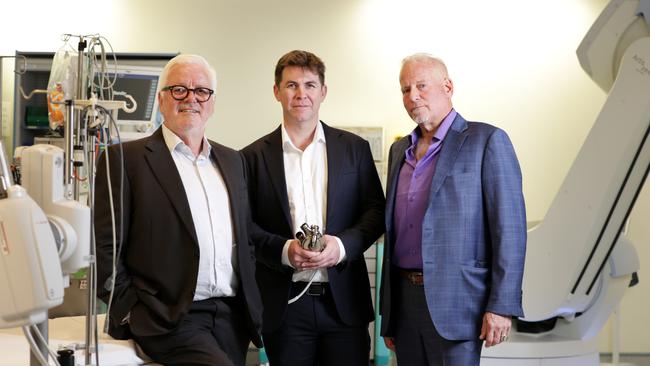
“We were optimistic, but we have been blown away by the outcomes,” Dr Timms said before the Australian surgery. “Our protocol was to aim for these patients to have the device for two months at least before they’d be well enough for a human heart transplant, before their kidneys and livers would be well enough to withstand another operation. But they got to this point in five days.
“The ultimate goal here is for this to be a replacement heart, an alternative to transplant, or maybe even better than transplant. We are not in the business of making a device that’s another also-ran. The principle from the very beginning was making a device that’s durable and that can last for decades.
“But our goal as we get to that stage is to take pragmatic steps to get to that point. Initially, it’s just a bridge to a transplant. So this is kind of like a proof of concept.”
For every operation performed so far, Dr Timms has watched on in theatre delivering expert engineering input, side by side with surgeons, anaesthetists and expert theatre nurses, as gravely ill patients are monitored every which way and hooked up to myriad tubes and hoses plugged into a heart-lung machine that drains, filters, cools and oxygenates the patient’s blood, removing the carbon dioxide before pumping it back inside the body. He left St Vincent’s Hospital in an Uber with the first Australian patient early last month in what must have been one of the highlights of the biomedical engineer’s life.
The surgery is easier than that practised on hundreds of animals over the past decade. It goes like this. The surgeons clamp the aorta, stopping native blood flow to the patient’s diseased heart, and the lungs. Anaesthetists completely deflate the patient’s lungs. Surgeons carefully cut the clamped aorta, and then the pulmonary artery. To implant the BiVACOR, they slice away the heart’s pumping chambers, leaving a tiny rim of atrial tissue to which the heart’s mitral and tricuspid valves attach, then they carefully take the valves out. Titanium doesn’t connect well to soft tissue, so a type of dacron material forms an interface between the metal and the patient’s heart tissue. They connect the rim of both atria of the heart to the dacron cuffs of the BiVACOR – marrying biology and bionics in a cutting-edge method.
“It’s almost like taking the door out, but just leaving the frame that encompasses the heart,” Dr Cohn says. “So now we’re looking at two big holes where the mitral valve and tricuspid valve used to be, looking down in the left atrium, seeing the veins coming back from the lungs, and we have the two ends of the aorta and the pulmonary artery. And then it’s just a matter of sewing four circles and making the artificial heart fit right.”
The BiVACOR invention was born of the urgency and power of love. Dr Timms’ father, Gary, was a plumber and as a boy Daniel would spend hours with his father on the lawn in the humid Ferny Hills dusk, building pumps for outdoor irrigation systems, or in their backyard shed sketching and crafting dummy versions of a rotary flowing non-pulsatile heart. The moulds became so voluminous in number that soon the family kitchen became an overflow repository for tools. Father and son were a regular instalment in their local Bunnings, where bemused staff indulged them as they sat on the floor for hours in the plumbing section trying to replicate the human body’s circulation system to plug their early rotary pump devices into.
The early design they created incorporated magnets made of coiled Bunnings-issue wire that wound around and around the device to create a magnetic field when it was switched on. Dr Timms developed this part of the invention by unfurling spools of wire on the family coffee table and carefully creating the turns. It took so long to perfect this aspect of the BiVACOR that the engineering work eventually cut a crevice into the Timms’ coffee table, prompting his mum to kick her son out of the living room for wrecking her furniture.
It was a deeply personal mission for father and son. Gary Timms had heart failure. Daniel raced against time to get his artificial heart ready for launch as his father’s heart grew weaker. It was relentless work that took him to all corners of the world to harness specific expertise – Japan for development of the BiVACOR’s centrifugal rotary pump and magnetic levitation technology, Germany for the device’s specialist prototyping, and Texas for their peerless clinical expertise.
Dr Timms was broke and no one would back him. The race against the clock was too slow for his father. Gary Timms died in 2008, in the same hospital where his son toiled so many hours, in Fraser’s ICU. He was just 55.
Heart failure afflicts 27 million people worldwide and kills almost 5000 people in Australia every year. The quest to save millions of lives with an effective artificial heart has stretched over 70 years and the Texas Heart Hospital has been right at the centre of it. The mission has been inspiring but frequently characterised by dashed hopes. The first artificial heart was put in a human chest at the Texas Heart Hospital in 1969. That patient lived for 64 hours.
“We know that we’re standing on the shoulders of giants,” says Dr Cohn, the chief medical officer of BiVACOR. “All the hearts that have come before this over the last seven decades have been pumping devices with inlet valves and outlet valves and flexible membranes.”
Existing artificial heart replacements only substitute for the left side of the heart, but the BiVACOR replaces both sides.
“No one has yet succeeded in making a durable artificial heart,” Dr Cohn says. “The only one that’s ever been approved was approved in the United States to keep a patient on the transplant list alive if they started to deteriorate, so you could get a transplant in.
“Other blood pumps shifted to rapidly spinning and magnetically levitated things, and those have been wildly successful, except for the fact that you have to leave the diseased heart in the chest. Daniel’s idea of making a total artificial heart that uses levitation of one spinning disc to do the work of both sides of the heart is just brilliant.”
Gary Timms is not alive to see this, but his widow, Daniel’s mum, is. She’s heading to Sydney to embrace her son. And she is so proud. If this works, Australia owes Mrs Timms a new coffee table.


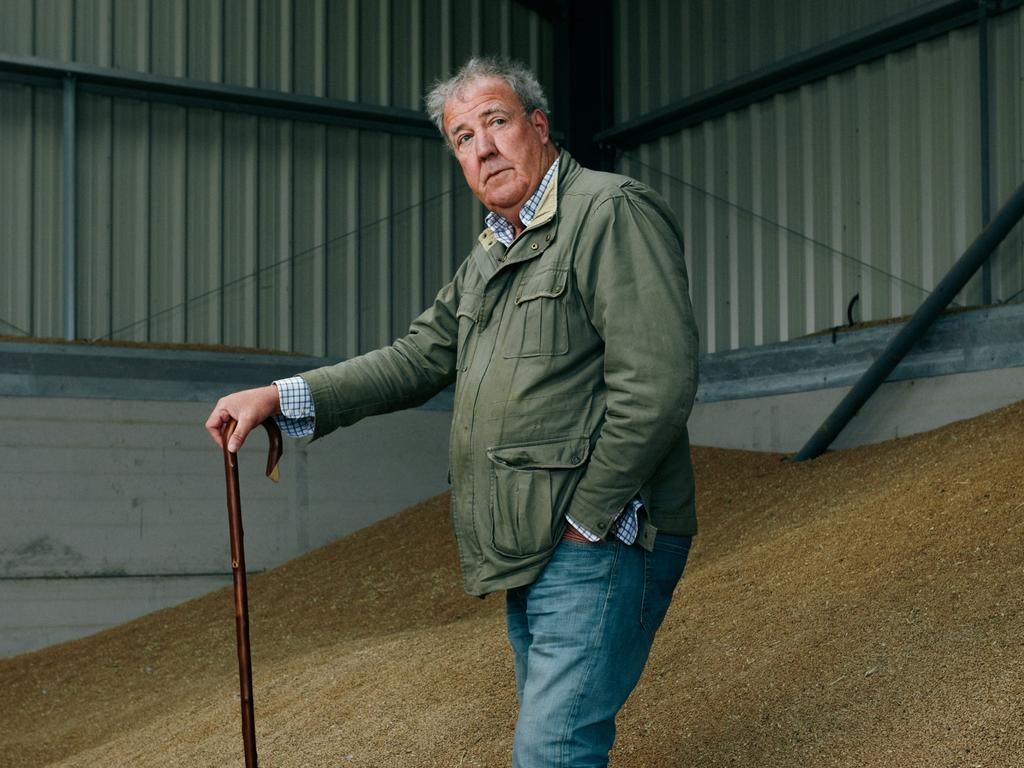

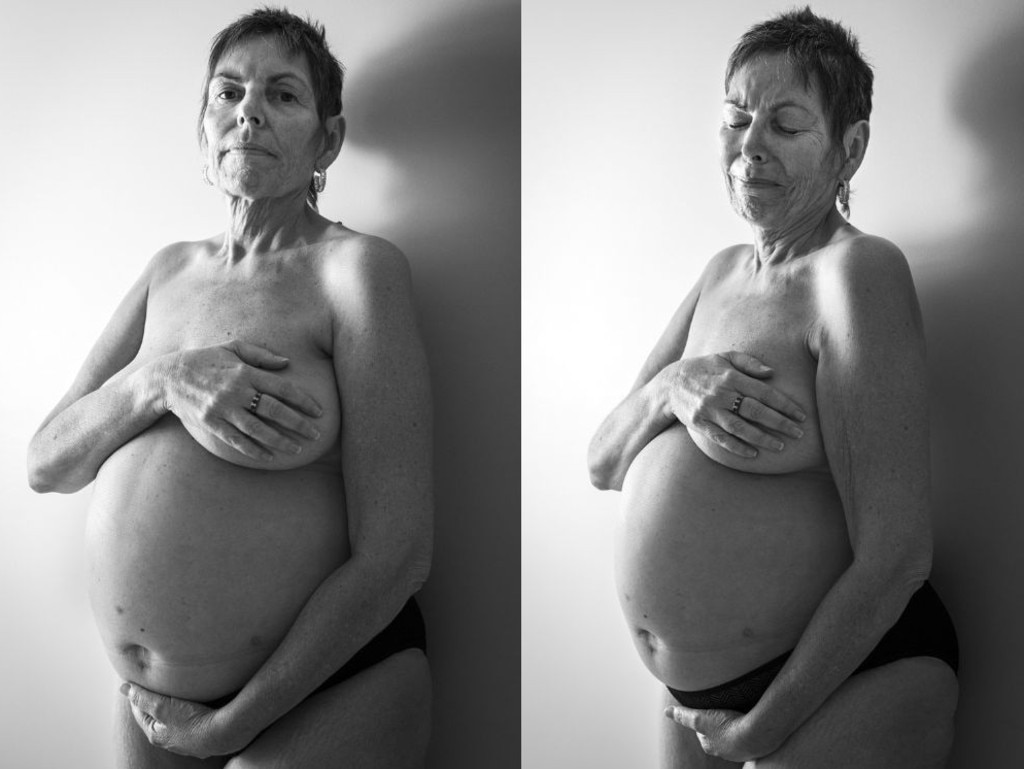
To join the conversation, please log in. Don't have an account? Register
Join the conversation, you are commenting as Logout